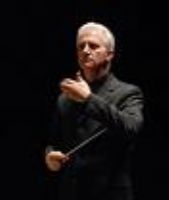|
Symphony
FROM THE NEW WORLD TO THE OLD WORLD
by Peter Lert
Saturday, June 14, 2025
Chamber
MC2 DUO RECITAL CLOSES 222'S SEASON
by Terry McNeill
Saturday, June 14, 2025
Choral and Vocal
CANTIAMO SONOMA'S LUSCIOUS A CAPELLA SINGING IN SEASON ENDING CONCERT
by Pamela Hicks Gailey
Sunday, June 8, 2025
Symphony
SRS SEASON ENDS WITH RESOUNDING TA-TA-TA-BANG
by Terry McNeill
Sunday, June 1, 2025
Symphony
YOUTHFUL VIRTUOSITY ON DISPLAY AT USO'S MAY CONCERTS
by Peter Lert
Saturday, May 17, 2025
Symphony
MYSTICAL PLANETS AND LIVELY GERSHWIN ORTIZ AT FINAL SRS CONCERT
by Peter Lert
Sunday, May 4, 2025
Symphony
VSO'S CONCERT MUSIC OF TIME, MUSIC OF PLACE
by Peter Lert
Sunday, April 27, 2025
VOCAL ELEGANCE AND FIRE AT THE 222'S RECITAL APRIL 26
by Pamela Hicks Gailey
Saturday, April 26, 2025
CANTIAMO SONOMA SINGS AN INSPIRED GOOD FRIDAY MOZART REQUIEM CONCERT
by Pamela Hicks Gailey
Friday, April 18, 2025
DRAMATIC SHOSTAKOVICH SYMPHONY CLOSES PHILHARMONIC'S 25TH SEASON
by Terry McNeill
Sunday, April 13, 2025
|
 |
 Conductor Gabriel Sakakeeny |
TWO PREMIERES AT APSC TENTH SEASON GALA
by Larry Flor
Sunday, May 10, 2009
The American Philharmonic Sonoma County presented their tenth season gala concert May 9 and 10 at the Wells Fargo Center, an event to celebrate a unique and accomplished performing arts organization. Most of the APSC musicians are advanced amateurs who volunteer their time to bring classical music to Sonoma County, including the work of musical director and primary conductor, Gabriel Sakakeeny. To celebrate a decade of innovative music making, the performances included two world premieres, a pianist new to the concerto performance arena, and the combined choirs of the Santa Rosa Symphonic Chorus under director Dan Earl, and the Santa Rosa Junior College Concert Choir with Jody Benecke directing.
The concert began with the world premiere of Pentangle by local composer Charles Sepos. Although a one-movement opus, the work had three distinct sections: Moderato, Andante, and Allegro. The highlight was the Andante, where the composer built forward momentum to set up the concluding Allegro. The first section was not memorable, and the Andante had deft moments but seemed overly long for the material at hand. At times the momentum was affected by uncertainty of instrumental entrances and thinness of orchestration, though perhaps the latter was the composer’s intention to depict transparency. Entrances and intonation were difficult for the brass section, but Pentangle was remarkable in its ability to project contrasts among strings and winds.
Concluding the first half was Tchaikovsky’s Piano Concerto in B Flat, Op. 23, with soloist Slade Trammell. A recent graduate of the University of Tennessee, Trammell was making his first performance on stage with an orchestra in the familiar three-movement Concerto, written in 1875. One cannot help but hear comparisons with so many recordings, and the volcanic interpretations by Horowitz and Argerich come to mind. Trammell demonstrated that he possesses the equipment to handle such a work, but the tempos he selected were safe, and there where spots where he was not in sync with the orchestra. Glances between soloist and conductor were noticeable. Intonation was again a problem in the lower strings, especially after the solo cadenza in the first movement. It was a good performance but a little pedantic, lacking the passion and intensity one expects to hear in a work with such soaring themes and thunderous orchestration. Trammell followed the Concerto with an encore, “Mexican Hat Dance,” arranged by his current teacher Earl Wild. The encore had rhythmic excitement.
The second half opened with another world premiere, Sakakeeny’s “The Lion and the Rose,” with mezzo-soprano soloist Jennifer Panara and the two combined choirs. It was led by guest conductor John Kendall Bailey. This was definitely a treat and a pity that it will be some time before it will be heard again. The piece grabs your attention from the opening through the skillful use of color, phrases and rhythm, and it keeps your attention throughout. It was not always easy to understand the words of the soloist due to the muddled acoustics in the Wells Fargo Center, but the music would have been understood in any language. Bravo to Sakakeeny’s opus, Bailey’s conducting, the orchestra and the choirs.
The concert ended with Ravel’s Suite No. 2 from Daphnis et Chloe, from 1912, conducted by Sakakeeny. Originally a ballet of an hour’s duration, Ravel extracted two richly hued suites. The orchestra seemed to find its stride during the second half. Gone were the inconsistencies of the opening segments, and Sakakeeny conducted with a firm grasp of the Ravel’s intentions. The orchestra responded in the “Danse Generale” with powerful sonority. The flute playing was particularly vivid, and balances were adroit.
The APSC has lots to celebrate after 10 years, as it is professional in every way, and a distinct service to the North Bay community.
|

